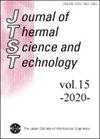甲烷-氢预混火焰的OH化学发光
IF 1.2
4区 工程技术
Q3 THERMODYNAMICS
引用次数: 3
摘要
在本研究中,研究了甲烷-氢预混火焰在本生灯上形成的OH化学发光。对于化学发光强度,我们得到了火焰边缘和火焰中轴线的值,并与阿贝尔反变换计算的值进行了比较。研究发现,由于综合化学发光强度对光路的影响较小,因此火焰中轴线处的测量值对测量位置的依赖程度小于火焰边缘处的测量值。此外,还测试了四种不同中心波长的滤光片。虽然滤光片改变了化学发光强度,但化学发光强度对等效比的依赖关系基本相同。为了进一步讨论,将一维甲烷氢火焰数值模拟预测的OH浓度和放热速率与实验中的OH化学发光和燃烧速度进行了比较。结果表明,即使在保持总当量比不变的情况下加入氢,OH的化学发光强度仍与CH和o2浓度反应产生受激OH*的速率成正比。同样,OH化学发光强度与放热速率有明显的相关关系。本文章由计算机程序翻译,如有差异,请以英文原文为准。
OH chemiluminescence of methane-hydrogen premixed flames
In this study, OH chemiluminescence of methane-hydrogen premixed flames formed on a Bunsen burner was investigated. As for the chemiluminescence intensity, we obtained the values at the edge of the flame and at the central axis of the flame, compared with the value calculated by the inverse Abel transform. It was found that the value at the central axis of the flame was less dependent on the measurement position than that at the edge of the flame, because the effect of integrated chemiluminescence intensity on the optical path was small. In addition, four filters with different center wavelengths were tested. Although the chemiluminescence intensity was changed by the filter, the dependence of the chemiluminescence intensity on the equivalence ratio was almost the same. For more discussion, the OH concentration and the heat release rate predicted by the numerical simulation of a one-dimensional methane-hydrogen flame were compared with the OH chemiluminescence and the burning velocity in experiments. It was revealed that, even when hydrogen was added by keeping the total equivalence ratio constant, the OH chemiluminescence intensity was proportional to the production rate of excited OH* produced by the reaction of CH and O 2 concentrations. Similarly, the OH chemiluminescence intensity was apparently related with the heat release rate.
求助全文
通过发布文献求助,成功后即可免费获取论文全文。
去求助
来源期刊
CiteScore
2.30
自引率
8.30%
发文量
0
审稿时长
5 months
期刊介绍:
JTST covers a variety of fields in thermal engineering including heat and mass transfer, thermodynamics, combustion, bio-heat transfer, micro- and macro-scale transport phenomena and practical thermal problems in industrial applications.

 求助内容:
求助内容: 应助结果提醒方式:
应助结果提醒方式:


